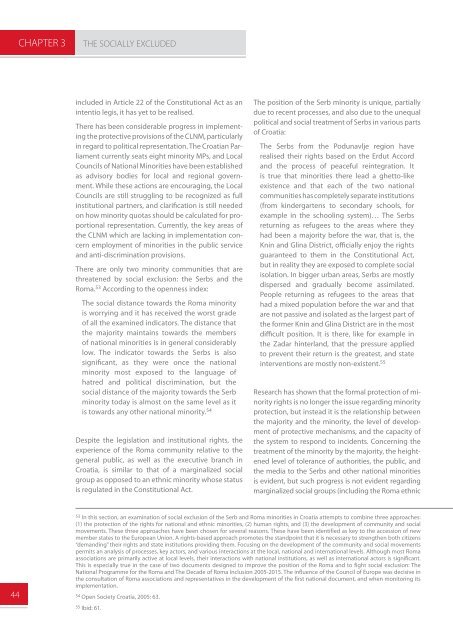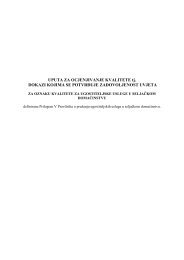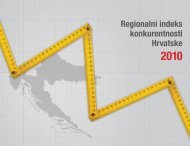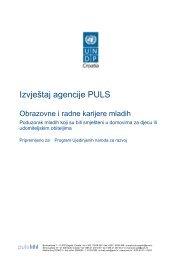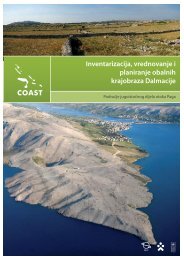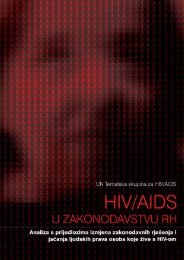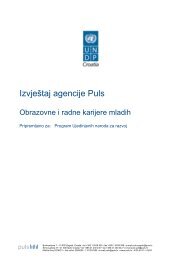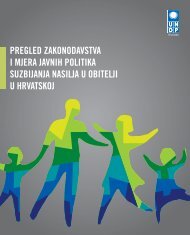WEB engleska verzija end.indd - UNDP Croatia
WEB engleska verzija end.indd - UNDP Croatia
WEB engleska verzija end.indd - UNDP Croatia
- No tags were found...
Create successful ePaper yourself
Turn your PDF publications into a flip-book with our unique Google optimized e-Paper software.
CHAPTER 3THE SOCIALLY EXCLUDEDincluded in Article 22 of the Constitutional Act as anintentio legis, it has yet to be realised.There has been considerable progress in implementingthe protective provisions of the CLNM, particularlyin regard to political representation. The <strong>Croatia</strong>n Parliamentcurrently seats eight minority MPs, and LocalCouncils of National Minorities have been establishedas advisory bodies for local and regional government.While these actions are encouraging, the LocalCouncils are still struggling to be recognized as fullinstitutional partners, and clarification is still neededon how minority quotas should be calculated for proportionalrepresentation. Currently, the key areas ofthe CLNM which are lacking in implementation concernemployment of minorities in the public serviceand anti-discrimination provisions.There are only two minority communities that arethreatened by social exclusion: the Serbs and theRoma. 53 According to the openness index:The social distance towards the Roma minorityis worrying and it has received the worst gradeof all the examined indicators. The distance thatthe majority maintains towards the membersof national minorities is in general considerablylow. The indicator towards the Serbs is alsosignificant, as they were once the nationalminority most exposed to the language ofhatred and political discrimination, but thesocial distance of the majority towards the Serbminority today is almost on the same level as itis towards any other national minority. 54Despite the legislation and institutional rights, theexperience of the Roma community relative to thegeneral public, as well as the executive branch in<strong>Croatia</strong>, is similar to that of a marginalized socialgroup as opposed to an ethnic minority whose statusis regulated in the Constitutional Act.The position of the Serb minority is unique, partiallydue to recent processes, and also due to the unequalpolitical and social treatment of Serbs in various partsof <strong>Croatia</strong>:The Serbs from the Podunavlje region haverealised their rights based on the Erdut Accordand the process of peaceful reintegration. Itis true that minorities there lead a ghetto-likeexistence and that each of the two nationalcommunities has completely separate institutions(from kindergartens to secondary schools, forexample in the schooling system)… The Serbsreturning as refugees to the areas where theyhad been a majority before the war, that is, theKnin and Glina District, officially enjoy the rightsguaranteed to them in the Constitutional Act,but in reality they are exposed to complete socialisolation. In bigger urban areas, Serbs are mostlydispersed and gradually become assimilated.People returning as refugees to the areas thathad a mixed population before the war and thatare not passive and isolated as the largest part ofthe former Knin and Glina District are in the mostdifficult position. It is there, like for example inthe Zadar hinterland, that the pressure appliedto prevent their return is the greatest, and stateinterventions are mostly non-existent. 55Research has shown that the formal protection of minorityrights is no longer the issue regarding minorityprotection, but instead it is the relationship betweenthe majority and the minority, the level of developmentof protective mechanisms, and the capacity ofthe system to respond to incidents. Concerning thetreatment of the minority by the majority, the heightenedlevel of tolerance of authorities, the public, andthe media to the Serbs and other national minoritiesis evident, but such progress is not evident regardingmarginalized social groups (including the Roma ethnic4453 In this section, an examination of social exclusion of the Serb and Roma minorities in <strong>Croatia</strong> attempts to combine three approaches:(1) the protection of the rights for national and ethnic minorities, (2) human rights, and (3) the development of community and socialmovements. These three approaches have been chosen for several reasons. These have been identified as key to the accession of newmember states to the European Union. A rights-based approach promotes the standpoint that it is necessary to strengthen both citizens“demanding” their rights and state institutions providing them. Focusing on the development of the community and social movementspermits an analysis of processes, key actors, and various interactions at the local, national and international levels. Although most Romaassociations are primarily active at local levels, their interactions with national institutions, as well as international actors is significant.This is especially true in the case of two documents designed to improve the position of the Roma and to fight social exclusion: TheNational Programme for the Roma and The Decade of Roma Inclusion 2005-2015. The influence of the Council of Europe was decisive inthe consultation of Roma associations and representatives in the development of the first national document, and when monitoring itsimplementation.54 Open Society <strong>Croatia</strong>, 2005: 63.55 Ibid: 61.


